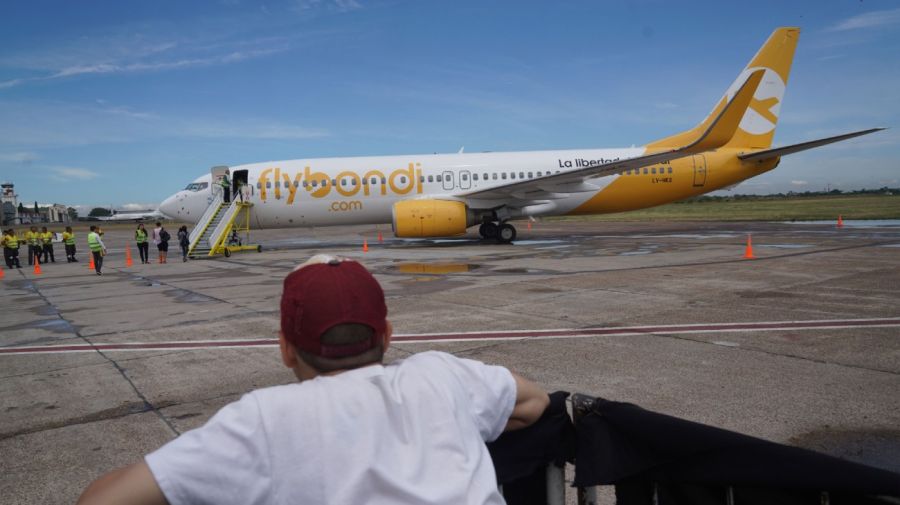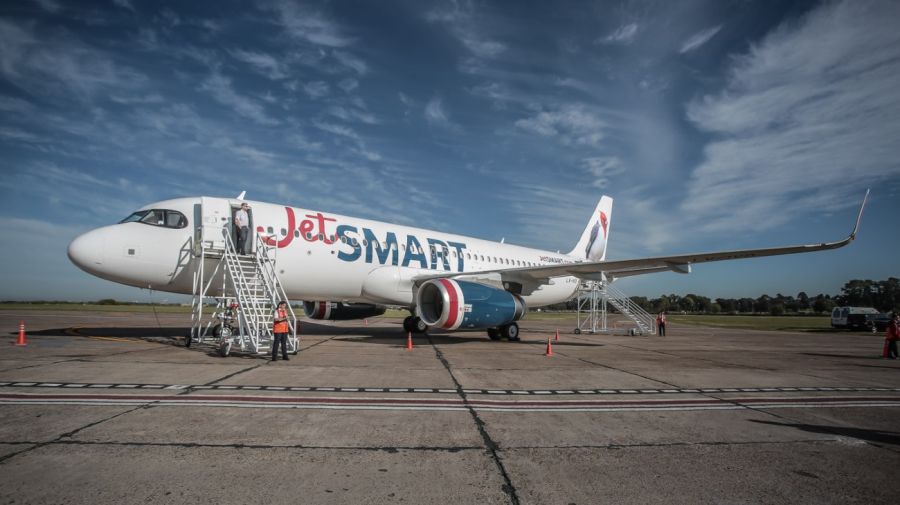There are few cases in which two competing companies decide to sit together for an interview. In an extensive conversation, the general managers of the only two low-cost carriers still operating in Argentina – Flybondi and JetSMART – agree on nearly all the significant issues facing the commercial aviation sector.
They include: the role of state carrier Aerolíneas Argentinas and the fact that if “they’re doing well, we can operate at ease”; LATAM’s traumatic exit and the opportunity it produced; taxation and high airport tax for passengers’ fares; the labour law freedom which allowed each company to have its own trade union; the need for an expansion at Aeroparque since “there is room, but not for us”; the importance of a further tourism promotion; their good relationship with Tourism & Sports Minister Matías Lammens; and the difficult juggling between supply and demand which either helps or not to adjust ticket prices to inflation.
Mauricio Sana, CEO of Flybondi, and Gonzalo Pérez Corral, CEO de JetSMART, did differ on one issue, naturally enough: their strategy to land new markets, one more local and the other more regional. Yet even over this point they found common ground, since they both state that the record-breaking total of domestic passengers in 2019, over 16 million, ought to reach 30 million with a commercial aviation policy setting that goal.
“The problem is they don’t understand that and ignore it,” they both assured us. There is plenty of room for growth in terms of comprehensive domestic flights before they make headway in winning markets from their direct competitors.
JetSMART and Flybondi are no longer just two airlines trying their luck in this country. They have operated for over five years, and despite competing against Aerolíneas Argentina with all that implies, they ended last year with 37 percent of the domestic flight market. Today one out of four people flying within Argentina do so via either airline.
What is more, a detailed analysis of the latest information of the National Civil Aviation Administration (ANAC, in its Spanish acronym) and the Transport Ministry shows that last year, as against 2021, the number of domestic passengers increased on average 121 percent, with JetSMART rising by 133 percent and Flybondi by 141 percent. Aerolíneas Argentinas grew by 116 percent, five percentage points below the average.
Fortuna: How is the domestic commercial aviation sector in Argentina in general and in particular the low-cost business?
Pérez Corral: The domestic market is clearly recovering after the pandemic, when both supply and demand fell. In 2022 we recovered the number of flights and passengers, but the 2019 levels were not reached, when there was a record year for domestic flights with 16 million passengers. It was also a positive year because routes which had been abandoned during the pandemic came back and all companies in the sector grew. It was a very good year for us, with improvement in occupancy and good prospects for 2023, hoping to overtake 2019 levels.
Sana: In 2021 the recovery which was consolidated last year started slowly, and we have 98 percent occupancy levels, but still without reaching that historic 2019. We understand that at a domestic level the next few years show good prospects. The Argentine market is, thanks to the low-cost entry, understanding and learning how to fly, generating new markets in domestic destinations, so that some of the results we had in 2022 should continue into next year.
The market share both low-cost carriers had in domestic flights in December, 2019 was 17 percent while you ended 2022 at 37 percent. What prompted this strong growth? How much influence did Latam’s exit have?
Sana: Even though our market share grew, they are numbers which sometimes don’t say much by themselves. We finished December with a 37 percent low-cost market share, but when we look at the size of the market, we are at around 98 percent of December, 2019. We still shrank by two percent, which is what we must aim at recovering and overtaking this year.
Pérez Corral: The key of this 37 percent was no doubt LATAM’s withdrawal. We did not eat up Aerolíneas Argentinas’ market, but all three carriers grew in the space left by such a big airline as Latam. Aerolíneas continued to grow, improved its occupancy rate and increased routes, as did our low-cost airlines.
Are three players too few or fine for the domestic market? Could there be more, like a few years ago?
Pérez Corral: There is no single answer. I believe that when each of us crunches numbers and looks at the economies of scale, we have to attempt to deal with costs better, this translates into better fares for consumers. We could argue for a long time about what the best thing is, but I think there may be room for more airlines and also smaller companies with smaller planes for regional flights and to link up with major routes, as in other countries. I think the dynamics are evolving and this is where we are today because the other companies don’t see an opportunity in Argentina or see it in other countries.
Sana: There is a point which has to do with the market response. This doesn’t move in terms of the number of competitors, but the size of the market and its characteristics. Our estimates show that we might have a domestic market near 30 million passengers, that is about 11 million more than the 16-million record in 2019. Whether this happens with three or 10 carriers depends on the commercial aviation policy. The potential is there. This country has one of the lowest numbers of domestic flights per capita. When we speak of 30 million, it doesn’t sound surrealistic, but the number of airlines depends on how the market is approached.
What would we have to do to reach those 30 million passengers, which means nearly doubling the record?
Sana: There is a very interesting point where the entire model comes in. We are players in a much larger commercial and operating chain. As airlines we are the tip of the iceberg, because there are airports providing supplementary services to passengers, from luggage to catering. The entrance at Aeroparque, given the renovations currently under way, is too overcrowded. When we speak of infrastructure, we understand that having 30 million passengers who can fly domestically in Argentina does not depend on the airlines but on where the country places its stakes and the plans of the governments for what could be a long-term commercial policy. The question is whether they are interested in growing or staying at 16 million passengers.
What do you think? Are they?
Sana: Our main job is to show them. It’s not whether or not governments are interested but that much of this has to do with their ignorance and lack of understanding. They just don’t see it. We don’t see the Transport Ministry thinking about a matrix which includes commercial aviation, but rather preferring to build a motorway. As an industry we understand, and that’s why we’re working together with JetSMART so that we can reach those 30 million. And these passengers won’t be for us alone but for a growth of the market which will make us all grow.
Pérez Corral: We talk a lot about a lack of incentives for foreigners in South America coming to Argentina and flying domestically. Last year we started flying to Asunción and we saw the number of Paraguayans coming to this country every month. There are some 30,000, and only 2,000 come by plane. When a Paraguayan buys a plane ticket including taxes, they must spend around US$100 per person for a return flight. This is because the airport tax in Argentina is the same as paid by a Japanese person going to Tokyo, and thus domestic flights are not being encouraged. The argument to lower that tax is that more aeroplanes could be filled with foreigners to bring more dollars into this country, which is difficult because those taxes are very high.
How did the closure of El Palomar affect you, and now having to operate between Aeroparque and Ezeiza?
Pérez Corral: Predictability is fundamental in our business. There was a time when due to the pandemic and political changes we didn’t know where our base of operations was, El Palomar, Aeroparque or Ezeiza. And that affects our business. We had to find rapid answers to be able to ensure the continuity of operations. This predictability is essential to be able to anticipate and plan things and then work on them actually happening and not having the rules change against the tide. It did affect us when El Palomar closed down because there was no answer about what was coming, instead uncertainty. When the cards were dealt again, we found a way to play with the new rules and fly again. Today we have operations in both airports, and we took it well, but it’s still not the ideal scenario, because we’re doubling our hubs in the same city with two different airports, which is also complex for passengers. Suggesting a return to El Palomar today would be to say that we are ready to triple our hubs. If two of them are already very expensive, three of them would be very difficult. The crucial thing is to define the commercial aviation policy for this country. Historically, Aeroparque was for domestic flights and today foreigners arriving there are being prioritised, who knows why. Today people from Tucumán have to arrive at Ezeiza and pay for a car ride which may be more expensive than the plane ticket.

Do you consider this Government had unfavourable policies for low-costs to favour the flag carrier?
Sana: That has to do with history. In 2016 Flybondi arrived with a new business model, low cost, which was not understood well here. There were actions to benefit or try to maintain the viability of a mixed company, which also had its own history. In 2018 we started operating with a different business model, a model of efficiency where we aim not to add costs to the state. We were very small when we got here. Today, over and above the commercial aviation policy of the past few years being good or bad, the screenshot last December shows that the low-cost model we brought is successful because the government bears no costs. According to our calculations, low-cost airlines have provided the State with twice as much as the state has spent on the flag carrier for it to subsist. We should consider that today between both low-cost airlines we pay over 30 percent of the fuel, more than 800 pesos per passenger going through the airport. We generate plenty of value and money for the State. Low-costs today can prove that 37 percent of the domestic market is profitable and the rest not. And that starts a different conversation.
What is the commercial balance of both companies, which is something the Government and the Economy Ministry look at carefully?
Sana: I think there are different ways of looking at it. The first one is simply as a commercial balance. We pay for the lease of the aircraft in dollars but over half our income is in pesos. I don’t think the issue here is whether there is a carry trade between dollars or pesos. The low-cost business today is positive in Argentina in financial terms due to the interesting cash flow we generate at a domestic level. The profitability of an airline is approximately five percent, maybe 10 percent. But in addition to us, there are at least eight players in the business chain, and the profitability of each of them is at least 20 percent between airports, governments, ground service providers, shopping, fuel, travel agents, etc.. At Flybondi we calculate that every passenger travelling to any destination spends a daily 5,000 pesos on average and the average stay of our passengers is between four and five days. And this money doesn’t go to the airline, it goes to the destination.
While we are on the subject, nearly 40 percent of your costs are in pesos and the remaining 60 percent in dollars. How does inflation, which affects that 40 percent of your costs, hit you against the dollar, which is pretty calm (for now) and impacts 60 percent of your costs?
Pérez Corral: The complexity of the aviation sector is that we sell well in advance, particularly in Argentina. People collect their wages in pesos, and look for shelter value. In January they’re already thinking about the winter break in July. In July we have to do the flight we sold in January with all the July costs: lease, fuel and the other services. That is the most difficult equation which needs plenty of intelligence as low-cost companies. As Mauricio says, it’s where we most need to pay attention for suitable pricing. Prices can’t always be adjusted for inflation because they do depend a lot on supply and demand. Last year, when supply was low in the industry, one could accommodate quickly and people would buy. But if the supply of flights is reinstated without demand growing or the market increasing, there’s a problem because we won’t be able to adjust prices for inflation.
Sana: Even though economic policy strongly affects the predictability of supply and demand, operations continue. With our monthly six percent inflation, or four percent on average in 2023 according to the latest reports, our customers are the biggest victims. Our goal is to try to stay alive financially, that is, not to lose money, and to try not to punish our passengers. That means in January I’m selling for July and I have to do it at July prices, but I shouldn’t overdo it because otherwise planes will be empty in July and that’s the worst equation.

Flybondi in numbers
– Six million have flown here since it began operations in 2018.
– 20 percent of its passengers are flying for the first time.
– A market share of 21 percent in domestic flights.
– 19 national routes and three international routes.
– 1,100 employees, of which 600 joined last year.
– US$500 million, its estimated turnover for 2023.
JetSMART in number
– 18 national routes. Regionally it has 75 routes, if we add JetSMART Peru and Chile.
– A 98 percent increase in its range of domestic flights between 2021 and 2022.
– 22 planes in the region.
– 186 passengers is the capacity of every Airbus 320 in Argentina.
– 350 employees. 52 percent female.
– Three percent of the freight transport market.
Quotes
Mauricio Sana, CEO of Flybondi
– “We’re necessary for the system. We’re here to add value to Argentina’s commercial aviation market.”
– “We see very good prospects for domestic flights over the next few years.”
– “Reaching 30 million domestic passengers depends on the government’s political decision-making.”
– “The low-cost model is successful because we don’t cost the state a thing. We have provided the state with twice as much as the state has spent on the flag carrier for it to subsist.”
– “We have proved that 37 percent of the domestic market is profitable, the rest is not.”
– “The better Aerolíneas Argentinas does, the greater ease with which we can operate.”
Quotes
Gonzalo Pérez Corral, CEO of JetSMART
– “Low-cost airlines have gone from 17 to 37 percent of the market after Latam’s exit. We’ve all gained market share.”
– “Other companies don’t see the commercial opportunities as we low-costs do.”
– “Predictability is fundamental in our business. Regardless of El Palomar, it’s important to define the country’s commercial aviation policy.”
– “Agents must understand that they have to do a little something extra to earn their commission.”
– “All private airlines in Argentina have gone broke, except for ours which are still running.”
No room at AEP?
‘Aeroparque has no room for us’
Many domestic flights are taking off at Ezeiza. So the question arises: Is it because Aeroparque has no more room? The answer of the CEOs of Flybondi and JetSMART is forceful: “They have no room for us.” As they explained, it is not space which is lacking but the decision by the Transport Ministry to authorise more planes at Aeroparque. They both calculated that between open parking – to be used now for Aerolíneas’ Airbus 330 which are to fly internationally - eight more planes could easily fit at Aeroparque’s area for private planes with more goodwill. “This would benefit all those travelling on domestic flights,” they said. Sana, from Flybondi, added: “Aeroparque could absorb 70 percent more flights but all of us players should work for it to make our operations as efficient as possible. It can be done, but it requires intent”.
Union tensions
Company unions versus the Industry
The Flybondi Aviation Workers’ Association (ATAF) and the JetSMART Workers’ Union (ASTJ) represent the workers of Flybondi and JetSMART respectively. Both unions issued a joint communiqué against the pilots and crew associations where they stated that they “bleed the flag carrier, and try to bring low-cost airlines on their knees” and that they are “slush funds for La Cámpora.” They also added that “today the dirty work of destroying low-cost airlines is carried out by the Labour Ministry itself, headed by Kelly Olmos.” In this area Mauricio Sana and Gonzalo Pérez Corral both agreed over their viewpoint: “At both companies we herald union freedom. Everyone has a choice. We know that 80 percent of union issues are about wages, that is why in our employment contracts wages are adjusted every six months for the inflation published by the National Statistics Bureau (INDEC),” the CEO of JetSMART said. “They see what happened to LATAM employees, and they don’t want that”, he added. Sana from Flybondi, in turn, explained: “Without a company there is no union. Today the market has two companies [Andes and Avianca] with a union but not flying”. Pérez Corral concluded: “All private airlines in Argentina have gone broke, except for ours which are still running. That has to mean something.”
Ministerial relations
Company unions versus the Industry
The Flybondi Aviation Workers’ Association (ATAF) and the JetSMART Workers’ Union (ASTJ) represent the workers of Flybondi and JetSMART respectively. Both unions issued a joint communiqué against the pilots and crew associations where they stated that they “bleed the flag carrier, and try to bring low-cost airlines on their knees” and that they are “slush funds for La Cámpora.” They also added that “today the dirty work of destroying low-cost airlines is carried out by the Labour Ministry itself, headed by Kelly Olmos.” In this area Mauricio Sana and Gonzalo Pérez Corral both agreed over their viewpoint: “At both companies we herald union freedom. Everyone has a choice. We know that 80 percent of union issues are about wages, that is why in our employment contracts wages are adjusted every six months for the inflation published by the National Statistics Bureau (INDEC),” the CEO of JetSMART said. “They see what happened to LATAM employees, and they don’t want that”, he added. Sana from Flybondi, in turn, explained: “Without a company there is no union. Today the market has two companies [Andes and Avianca] with a union but not flying”. Pérez Corral concluded: “All private airlines in Argentina have gone broke, except for ours which are still running. That has to mean something.”






















Comments